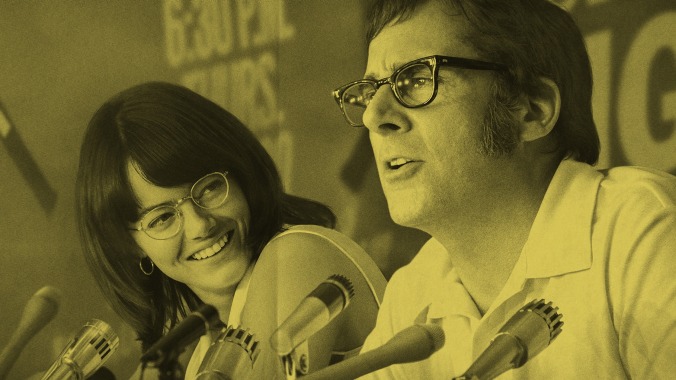Battle Of The Sexes turns an outrageous tennis match into a modest crowdpleaser

The Battle Of The Sexes, which pitted the 29-year-old top-ranked women’s tennis player Billie Jean King against the 55-year-old retired men’s pro Bobby Riggs, was a circus. Riggs, in the part of the avowed male chauvinist and opponent of women’s lib, entered the Houston Astrodome—about as un-tennis a setting as possible—in a rickshaw pulled by buxom models to the theme music from the old Technicolor swashbuckler Captain From Castile. To squeeze more money out of the match, he had signed one contract to promote Sugar Daddy’s caramel suckers (with the famous stipulation that he play the match in a ridiculous windbreaker), and another to hawk Hai Karate, the budget aftershave famous for commercials in which men beat back lusting women with martial arts moves. King, the challenger, came in blue suede shoes and a dress designed by Ted Tinling, the wizard of tennis couture, carried on an ostrich-feather palanquin by Ancient Egyptian beefcakes while Helen Reddy performed her hit, “I Am Woman.” For Riggs, she brought a piglet.
The event, broadcast on September 20, 1973 to a worldwide TV audience, remains the most watched in the history of American tennis. But as a game, it was dull and mostly one-sided; the most damning proof of the sexism of the era’s tennis culture is the fact that Riggs was ever considered a favorite to win. Nonetheless, the match remains one of those quintessentially American culture-wars publicity stunts that seems to inspire a new unproduced film script every couple of years. Battle Of The Sexes, a minor crowdpleaser from the duo of Valerie Faris and Jonathan Dayton (Little Miss Sunshine, Ruby Sparks) that stars Emma Stone as King and Steve Carell as Riggs, is the first one to actually get off the ground since the TV movie When Billie Beat Bobby back in 2001. Though told in broad strokes, its version of the story deserves credit for never buying into the hype and surreal pageantry of the Astrodome showdown. But its lack of interest in tennis as a sport leaves the narrative—plastered with hot-button issues and character crises—with an empty center.
1973 was a busy year for King, who founded the Women’s Tennis Association mere months before the match against Riggs. The script, which is credited to Simon Beaufoy, compresses her biography even further: It places King’s mock-rivalry with Riggs side-by-side with her public fight for pay equality in the early ’70s and her private coming to terms with her sexuality in the late ’60s. Defying the tennis-legend-turned-promoter Jack Kramer (Bill Pullman), she forms a new professional tour with the help of World Tennis publisher Gladys Heldman (Sarah Silverman, sporting a Susan Sontag hairdo) and a Virginia Slims sponsorship, drawing in a roster of world-class players. Riggs, an unapologetic compulsive gambler decked out in horn-rimmed glasses and wild sideburns, is living out a TV-equipped Rolls-Royce that he won in a bet when he calls King out of the blue to pitch his idea for a male chauvinist vs. feminist match—a cockamamie offer that King initially rejects.
King and Riggs became lifelong friends in real life, and Battle Of The Sexes paints them as kindred spirits, drawing a clear distinction between Jack Kramer’s patronizing sexism and Riggs’ clownish, burlesque hustling of the zeitgeist. He has been kicked out of the mansion by his wife because of his gambling antics; she is pursuing a tour romance with a hairdresser (Andrea Riseborough) while her husband manages her career from home. In keeping with the rococo style of motivation that has come to define modern scripts, the movie gives King and Riggs a litany of reasons to compete (attention, recognition, sticking it to Kramer, etc.), but none to play; the direction of the title event is weightless and pedestrian, like a highlights reel. Is it so hard to imagine that professional athletes might have an obsession with the game that goes beyond the narrative rationale of winning? Might they have some relationship to their bodies that the average person doesn’t have?
At the risk of offering script notes to an already finished film: Shouldn’t this be obvious to a movie whose two main characters are grappling with aging and sexuality? But depictions of sport notwithstanding, Faris and Dayton have done their homework. They take visual inspiration from the films of the late 1960s and early ’70s to study their characters through telephoto lenses and the inbuilt frames of high-rise hotels, motor lodge motels, mid-century lobbies, and vintage TVs. There are brief, lovely moments throughout, invested in the contradictions of the tour lifestyle—constantly moving from place to place and feeling lonely while surrounded by the same group of outspoken characters. Perhaps a purer version of Battle Of The Sexes would dispense with the tennis altogether (there are very few scenes of characters practicing or playing), and consist of nothing but hotel rooms, phone calls, and lightly eroticized scenes of characters getting haircuts. But then it wouldn’t have much of a reason to exist.